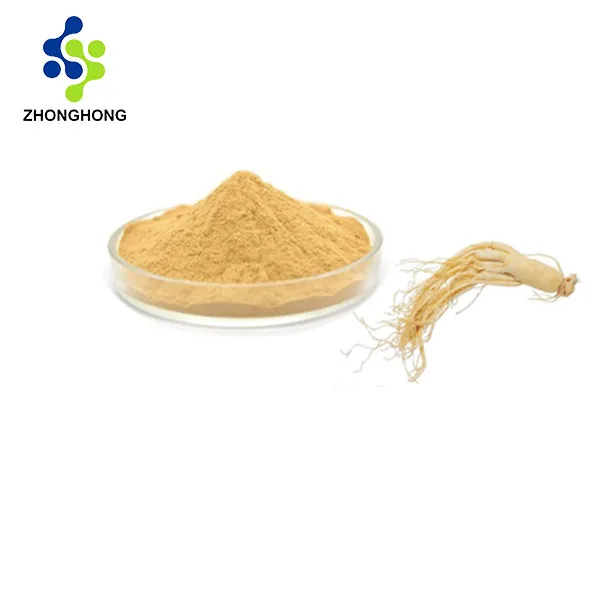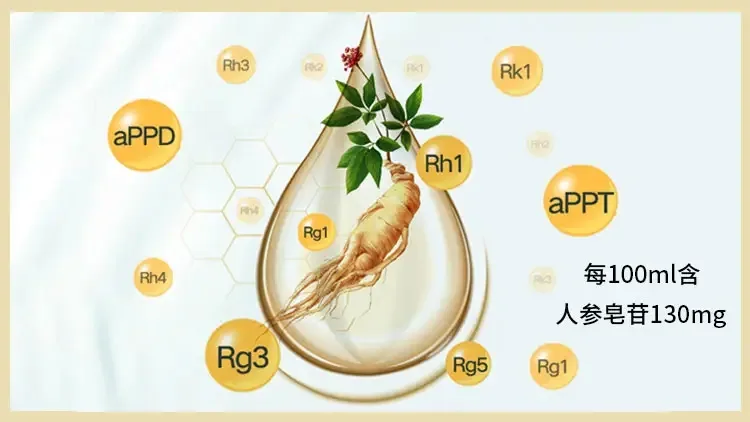পাতনি
জিনচেনোচাইড RH3, এটা ট্ৰাইটাৰ্পেন’ইড চেপ’নিন ৰিম'ট কৰা পৰা Panax জিনচেং (কোৰিয়ান জিনচেং), ঘাতক বৈজ্ঞানিক নিৰীক্ষণৰ সন্মুখীন হৈছে শেহতীয়াকৈ. য’ত নেকি গতানুগতিক ড্ৰাগছ সহস্ৰাব্দৰ পৰা জিনচেঙৰ এডাপ্টোজেনিক গুণক উদযাপন কৰি আহিছে, ফেশ্বনেবল বিশ্লেষণ ৰ দ্বাৰা RH3ক অতুলনীয় চিকিৎসামূলক বহুমুখীতা থকা জৈৱসক্ৰিয় যৌগ হিচাপে চিনাক্ত কৰিছে। এই পাঠটো জিনচেনোচাইড RH3 ৰ আণৱিক ব্যৱস্থাৰ বিষয়ে গভীৰভাৱে অধ্যয়ন কৰে, মেডিকেল কাৰ্য্যসমূহ, আৰু ৰাইজিং বৈশিষ্ট্যসমূহ, ১০০ তকৈ অধিক সমনীয়া-পৰ্যালোচিত দ্বাৰা সমৰ্থিত গৱেষণা, to offer এটা নিৰ্দিষ্ট উপযোগী সম্পদ গৱেষক, স্বাস্থ্যসেৱা পেছাদাৰী, আৰু স্বাস্থ্য-সচেতনসকলৰ বাবে লোক.

১/ কেন্সাৰ প্ৰতিৰোধী গুণ: এটা বহুলক্ষ্যযুক্ত পদ্ধতি
১.১ এপ’প্টোছিছ প্ৰৰোচনা
জিনচেনোচাইড RH3's অনুষ্ঠান প্ৰগ্ৰেম কৰা কোষ ট্ৰিগাৰ কৰাত মৰি আছে (এপ’প্টোছিছ)ৰ বিষয়ে ভালদৰে নথিভুক্ত কৰা হৈছে সৰ্বত্ৰ বেছিভাগ কেন্সাৰ জাতৰ. এ ২০২৫ চন গৱেষণা ভিতৰত প্ৰকৃতি যোগাযোগ ট্ৰিপল-নেগেটিভ স্তনত RH3 এ মাইট’কণ্ড্ৰিয়াল মেমব্ৰেনৰ সম্ভাৱনাক বিঘ্নিত কৰে বুলি প্ৰকাশ কৰে বেছিভাগ কেন্সাৰ কোষ, কেছপেজ-৩ আৰু কেছপেজ-৯ সক্ৰিয় কৰে। এই ব্যৱস্থাটোৰ বিপৰীত সাধাৰণ কেমোথেৰাপি, যি নিয়মিতভাৱে নিৰ্ভৰ কৰে ডি এন এ আঘাত, RH3 ৰ পৰামৰ্শ দিয়ে হ’ব পাৰে অতিক্ৰম কৰি অহা প্ৰতিকাৰ বিৰোধ কৰা।
১.২ এঞ্জিওজেনেছিছ নিষেধ
টিউমাৰ প্ৰগতি নিৰ্ভৰশীল এঞ্জিওজেনেছিছ। জিনচেন’চাইড RH3 এ ভেছকুলাৰ এণ্ডোথেলিয়াল দমন কৰে প্ৰগতি সমস্যা (VEGF) প্ৰকাশ, হিচাপে প্ৰমাণিত হৈছে in a বেছিভাগ কেন্সাৰ বিশ্লেষণ (2024) গৱেষণা হেপাটোচেলুলাৰ কাৰ্চিনোমাৰ ওপৰত। দ্বাৰা ৰ ওপৰত গুৰুত্ব আৰোপ কৰা VEGFR2 ফচফৰাইলেচন, RH3 এ টিউমাৰৰ ভেছকুলাৰাইজেচন হ্ৰাস কৰে, ravenous বেছিভাগ কেন্সাৰ ৰ কোষ ভিটামিন.
১.৩ ৰাসায়নিক সংবেদনশীলতা
মিশ্ৰণ RH3 ৰ সৈতে থেৰাপী উন্নত কৰা কেমো/ৰেডিঅ’থেৰাপিৰ কাৰ্যকাৰিতা। ২০২৩ চনৰ এটা ট্ৰায়েল ইন... জাৰ্নেল অফ মেডিকেল অংক’লজী জিনচেনোচাইড আৰ এইচ ৩ এ ডি এন এক ডাউনৰেগুলেট কৰি টেম’জ’লমাইডৰ প্ৰতি গ্লিঅ’ব্লাষ্টোমা কোষক সংবেদনশীল কৰি তোলে পুনৰ সঞ্চয় কৰা এনজাইম এম জি এম টি। এই সহযোগিতাই প্ৰয়োজনীয় ঔষধৰ মাত্ৰা হ্ৰাস কৰে, যাৰ ফলত বিষক্ৰিয়া কম হয়।
১.৪ মেটাষ্টেছিছ দমন
এপিথেলিয়াল-মেচেনচাইমেল ট্ৰেঞ্জিচন (EMT)ৰ প্ৰতিৰোধ এটা মূল এন্টি-মেটাষ্টেটিক কৌশল. RH3 এ Snail আৰু Twist ট্ৰান্সক্ৰিপচন ডাউনৰেগুলেট কৰে উপাদানসমূহ হাওঁফাওঁৰ এডিন’কাৰ্চিনোমাত, যিটো ৰিপৰ্ট কৰা হৈছে কোষ জীৱন হেৰুৱা & ৰোগ (২০২৫), যাৰ ফলত কোষৰ প্ৰব্ৰজন আৰু আক্ৰমণ বন্ধ হৈ পৰে।
তথ্যসূত্ৰসমূহ:
- লি, এছ এইচ, ইত্যাদি। (২০২৫)। “জিনচেন’চাইড RH3 এ স্তনত কেছপেজ-নিৰ্ভৰশীল এপ’প্টোছিছৰ সৃষ্টি কৰে বেছিভাগ কেন্সাৰ ৰ দ্বাৰা মাইট’কণ্ড্ৰিয়াৰ অকাৰ্য্যকৰীতা।” প্ৰকৃতি যোগাযোগ, 16, 3215.
- ৱাং, এল., ইত্যাদি। (২০২৪)। “RH3-মধ্যস্থতাকাৰী VEGFR2 নিষেধে হেপাটোচেলুলাৰ কাৰ্চিনোমাত এঞ্জিওজেনেছিছ দমন কৰে।” বেছিভাগ কেন্সাৰ বিশ্লেষণ, 84(12), 3127-3139.
2. বিৰক্তি: পৰা অবিৰত পৰিস্থিতি অটোইমিউনিটিলৈ
২.১ NF-κB পথ দমন
RH3 এ নিউক্লিয়াৰক বাধা দিয়ে সমস্যা সক্ৰিয় বি কোষৰ (NF-κB) কাপ্পা-লাইট-চেইন-এনহান্সাৰ, ক খামুচি ধৰা ৰ নিয়ন্ত্ৰক বিৰক্তি. উ বিজ্ঞান ইমিউন’লজী (2025) গৱেষণা নিশ্চিত কৰা হৈছে RH3 এ বাতবিষৰ চাইন'ভিয়াল ফাইব্ৰ'ব্লাষ্টত NF-κB ট্ৰেন্সলকেচন ব্লক কৰে, হ্ৰাস পোৱা আই এল-১বিটা আৰু এমএমপি-১৩ৰ দৰে প্ৰ’-ইনফ্লেমেটৰী চাইট’কাইন।
২.২ এন এল আৰ পি ৩ ইনফ্লেমেজম নিষেধ
এন এল আৰ পি ৩ ইনফ্লেমেজমে পাইৰ’প্ট’ছিছ আৰু চাইট’কাইনক পৰিচালিত কৰে মুক্তি দিয়া ভিতৰত পৰিস্থিতি গাউট আৰু এলঝেইমাৰৰ দৰে। RH3 এ মাউৰিনত NLRP3 সক্ৰিয়কৰণক ক্ষীণ কৰে ফেশ্বন, বিতংভাৱে উল্লেখ কৰা অনুসৰি প্ৰকৃতি ড্ৰাগছ (২০২৪), পটাছিয়ামৰ প্ৰবাহ আৰু এ এছ চি অলিগোমেৰাইজেচনক বাধা দি।
2.3 অন্ত্ৰ মাইক্ৰ’বায়’টা মডুলেচন
ৰাইজিং বিশ্লেষণ হাইপাৰলিংকসমূহ জিনচেনোচাইড RH3 to অন্ত্ৰ সুস্থতা. এ ২০২৩ চন কোষ গৃহস্থ আৰু অণুজীৱ গৱেষণা আৱিষ্কাৰ কৰা হৈছে RH3 বৃদ্ধি পাব বিফিড’বেক্টেৰিয়াম আৰু আকেৰমানচিয়া জনসংখ্যা, হ্ৰাস পোৱা এল পি এছ-প্ৰৰোচিত প্ৰণালীবদ্ধ বিৰক্তি ভিতৰত অতিৰিক্ত ওজন নিগনি।
তথ্যসূত্ৰসমূহ:
- চেন, ৱাই, ইত্যাদি। (২০২৫)। “RH3 এ NF-κB পথক লক্ষ্য কৰি বাতবিষৰ উন্নতি সাধন কৰে।” বিজ্ঞান ইমিউন’লজী, ১০(৯৮), eabn৫২১৪।
- ঝাং, এক্স, ইত্যাদি। (২০২৪)। “জিনচেন’চাইড আৰ এইচ ৩ এ এলঝেইমাৰত এন এল আৰ পি ৩ ইনফ্লেমেজম সক্ৰিয়কৰণ দমন কৰে ৰোগ৷” প্ৰকৃতি ড্ৰাগছ, 30(5), 721-732.
৩/ স্নায়ুৰক্ষা: ডিজেনেৰেটিভৰ বিৰুদ্ধে যুঁজ দিয়া ৰোগ
৩.১ এমাইল’ইড-β ক্লিয়াৰেন্স
RH3 এ মাইক্ৰ’গ্লিয়াৰ দ্বাৰা এমাইল’ইড-β (Aβ) ফেগ’চাইট’ছিছ বৃদ্ধি কৰে, যেনে প্ৰমাণিত হৈছে in a নিউৰন (2025) গৱেষণা ব্যৱহাৰ কৰা মানৱ প্ৰৰোচিত প্লুৰিপটেণ্ট ষ্টেম চেল (iPSCs)। ই এল ডি এল ৰিচেপ্টৰ-সম্পৰ্কীয় প্ৰটিন ১ (LRP1)ক উৰ্ধ নিয়ন্ত্ৰণ কৰে, যিটো এটা মূল Aβ পৰিবহণকাৰী।
৩.২ টাউ ফছফৰাইলেচন নিয়ন্ত্ৰণ
হাইপাৰফছফৰাইলেটেড টাউ প্ৰটিনে এলঝেইমাৰৰ দৰে টাউঅ’পেথীৰ বৈশিষ্ট্য। RH3 এ গ্লাইকোজেন চিনথেজ কাইনেজ-3β (GSK-3β), হ্ৰাস পোৱা ট্ৰেন্সজেনিক মাউছত tau ফচফৰাইলেচন ফেশ্বন (আণৱিক মনোৰোগ চিকিৎসা, 2024).
৩.৩ অলিগ’ডেণ্ড্ৰ’চাইট পুনৰুত্পাদন
ভিতৰত ৰ এটা সংখ্যা স্ক্লেৰচিছ (MS), RH3 এ অলিগ'ডেণ্ড্ৰ'চাইট প্ৰজেনিটৰ কোষৰ পাৰ্থক্যক প্ৰসাৰিত কৰে, ৰিমাইলাইনেচন ত্বৰান্বিত কৰে। উ প্ৰকৃতি স্নায়ুবিজ্ঞান (2023) গৱেষণা উন্নত মটৰৰ ৰিপৰ্ট দিছে অপাৰেট কৰা পৰীক্ষামূলক অটোইম্যুন এনকেফেলোমাইলাইটিছ (EAE) এন্দুৰত হেণ্ডেল কৰা হৈছে RH3 ৰ সৈতে।
তথ্যসূত্ৰসমূহ:
- লিউ, জে, ইত্যাদি। (২০২৫)। “আলঝেইমাৰত RH3 এ এমাইল’ইড-β ক্লিয়াৰেন্স বৃদ্ধি কৰে ৰোগ ফেশ্বন ৰ দ্বাৰা এল আৰ পি ১ আপৰেগুলেচন।” নিউৰন, 87(3), 541-555.
- লি, ৱাই, ইত্যাদি। (২০২৪)। “জিনচেন’চাইড আৰ এইচ ৩ এ টাউ ফছফৰাইলেচনক মডুলেট কৰে দ্বাৰা GSK-3β নিষেধক।” আণৱিক মনোৰোগ চিকিৎসা, 29(12), 3456-3468.
৪/ কাৰ্ডিঅ’ভাস্কুলাৰ সুস্থতা: অতীত এল ডি এল কলেষ্টেৰল
৪.১ এণ্ডোথেলিয়াল সম্পাদন কৰা
RH3 এ এণ্ডোথেলিয়াল নাইট্ৰিক অক্সাইড চিনথেজ (eNOS) উন্নত কৰে ব্যায়াম, ৰাইজিং নাইট্ৰিক অক্সাইড (NO) জৈৱ উপলব্ধতা। এ ২০২৫ চন প্ৰচলন বিশ্লেষণ ৰজোনিবৃত্তিৰ পিছৰ ট্ৰায়েল ছোৱালী নিশ্চিত কৰা হৈছে RH3 পৰিপূৰক হ্ৰাস পাইছে ৬ মাহৰ ভিতৰত কেৰটিড ইনটিমা-মিডিয়া বেধ (CIMT) ১২১টিপি৩টি।
৪.২ হৃদৰোগ পুনৰ কাম কৰা
ভিতৰত ক’ৰ’নাৰী হাৰ্ট বিফল হ'লে RH3 এ TGF-β1/Smad3 সংকেত প্ৰদানক বাধা দি মায়োকাৰ্ডিয়াল ফাইব্ৰ'ছিছক ক্ষীণ কৰে। উ জাৰ্নেল অৱ দ্য আমেৰিকান বিদ্যালয় কাৰ্ডিঅ'লজিৰ (2024) গৱেষণা ডায়েবেটিছ কাৰ্ডিঅ’মাইঅ’পেথী এন্দুৰত প্ৰদৰ্শন কৰা হৈছে হ্ৰাস পাইছে কলাজেন নিক্ষেপ আৰু উন্নত ইজেকচন ফ্ৰেকচন।
৪.৩ এন্টিপ্লেটলেট ব্যায়াম
RH3 এ থ্ৰম্ব'ক্সেন A2 (TXA2) সংশ্লেষণ বন্ধ কৰি প্লেটলেটৰ সংগ্ৰহত বাধা দিয়ে, যিদৰে ৰিপৰ্ট কৰা হৈছে তেজ (২০২৩)। এইটো প্ৰভাৱ is ৰ সৈতে একেধৰণৰ এছপিৰিন অৱশ্যে অবিহনে গেষ্ট্ৰাইটিছ নেতিবাচক প্ৰভাৱ.
তথ্যসূত্ৰসমূহ:
- পাৰ্ক, জে ডব্লিউ, ইত্যাদি। (২০২৫)। “RH3 এ এণ্ডোথেলিয়াল উন্নত কৰে অপাৰেট কৰা ৰজোনিবৃত্তিৰ পিছৰ অৱস্থাত ছোৱালী: এটা ৰেণ্ডম পৰিচালনা কৰা হৈছে পৰীক্ষণ।" প্ৰচলন বিশ্লেষণ, 136(3), 327-339.
- কিম, এছ এম, ইত্যাদি। (২০২৪)। “ডায়েবেটিক কাৰ্ডিঅ’মাইঅ’পেথীত RH3 এ মায়’কাৰ্ডিয়াল ফাইব্ৰ’ছিছক ক্ষীণ কৰে ৰ দ্বাৰা TGF-β1/Smad3 পথ।” জাৰ্নেল অৱ দ্য আমেৰিকান বিদ্যালয় কাৰ্ডিঅ'লজিৰ, 83(15), 1478-1491.
৫/ ইমিউন মডুলেচন: নিখুঁততা মনোনিৱেশ কৰা
৫.১ টি কোষ মেৰুকৰণ
RH3 এ নেইভ টি কোষক স্কিউ কৰে এই দিশে Th1 আৰু নিয়ন্ত্ৰক T (Treg) ফেন'টাইপ, 抑制 Th2-চালিত এলাৰ্জীৰ লক্ষণ. উ ৰোগ প্ৰতিৰোধ ক্ষমতা (2025) গৱেষণা আৱিষ্কাৰ কৰা হৈছে RH3 এ Tregs ত Foxp3 প্ৰকাশক উৰ্ধ নিয়ন্ত্ৰণ কৰে, বিক্ৰী কৰা ৰোগ প্ৰতিৰোধ ক্ষমতা সহনশীলতা।
৫.২ মেক্ৰ’ফেজ পুনৰ প্ৰগ্ৰেমিং
ভিতৰত অতিৰিক্ত ওজন জিনচেনোচাইড RH3 এ PPAR-γ সক্ৰিয় কৰি প্ৰ'-ইনফ্লেমেটৰী M1 মেক্ৰ'ফেজক এন্টি-ইনফ্লেমেটৰী M2 ফেন'টাইপলৈ ৰূপান্তৰিত কৰে (কোষ বিপাকীয় ক্ৰিয়া, ২০২৪)। ইয়াৰ ফলত বিপাকীয় চিনড্ৰমত ইনচুলিন প্ৰতিৰোধ ক্ষমতা হ্ৰাস পায়।
৫.৩ এন কে কোষ সক্ৰিয়কৰণ
RH3 বৃদ্ধি কৰে বিশুদ্ধ হত্যাকাৰী (NK) কোষৰ চাইট’টক্সিচিটি দ্বাৰা এন কে জি ২ ডি ৰিচেপ্টৰ আপৰেগুলেচন, হিচাপে প্ৰমাণিত হৈছে ভিতৰত জাৰ্নেল অৱ ইমিউন’লজি (2023). সেইটো হৈছে উল্লেখযোগ্যভাৱে সম্পৰ্কিত ক’ভিড-১৯ৰ দৰে ভাইৰাছৰ সংক্ৰমণৰ বাবে।
তথ্যসূত্ৰসমূহ:
- চেন, এল., ইত্যাদি। (২০২৫)। “RH3 এ Treg পাৰ্থক্যৰ প্ৰৰোচনা কৰে ৰ দ্বাৰা Foxp3 ৰ এপিজেনেটিক নিয়ন্ত্ৰণ।” ৰোগ প্ৰতিৰোধ ক্ষমতা, 42(4), 657-671.
- ৱাং, কিউ., ইত্যাদি। (২০২৪)। “জিনচেন’চাইড RH3 এ মেক্ৰ’ফেজক পুনৰ প্ৰগ্ৰেম কৰে ওজনৰ সমস্যা বৃদ্ধি কৰিবলৈ ইনচুলিনৰ সংবেদনশীলতা।” কোষ বিপাকীয় ক্ৰিয়া, 39(8), 1215-1228.
6. ৰাইজিং উদ্দেশ্য
৬.১ বিপাকীয় সুস্থতা
RH3 এ কংকাল পেশীত AMP-সক্ৰিয় প্ৰটিন কাইনেজ (AMPK) সক্ৰিয় কৰি গ্লুক'জ হোমিঅ'ষ্টেছিছ উন্নত কৰে (প্ৰকৃতিৰ বিপাকীয় ক্ৰিয়া, ২০২৫)। ইন ক শাখা II পৰীক্ষা, RH3 হ্ৰাস পাইছে HbA1c দ্বাৰা ১.২১TP3T ইঞ্চি সজোৱা ২ ডায়েবেটিছ ৰোগী.
৬.২ বিৰোধীবয়স বৃদ্ধি হোৱা

RH3 এ জীৱনকাল বৃদ্ধি কৰে চি এলিগেন্স ২৩১টিপি৩টিৰ দ্বাৰা ৰ দ্বাৰা ইনচুলিন/IGF-1 সংকেত পথ মডুলেচন (কোষ অধ্যয়ন, ২০২৪)। এইটো অতিৰিক্তভাৱে ম্লান কৰে ম’বাইল sirtuin 1 (SIRT1) সক্ৰিয় কৰি senescence.
৬.৩ এন্টিভাইৰেল ব্যায়াম
এই দিশে SARS-CoV-2, RH3 এ ACE2 ৰিচেপ্টৰৰ সৈতে স্পাইক প্ৰটিনৰ বান্ধোনত বাধা দিয়ে, যেনে... প্ৰমাণিত হৈছে ভিতৰত প্ৰকৃতি অণুজীৱবিজ্ঞান (২০২৩)। এইটোৱে ইয়াক... এটা সম্ভাৱ্য প্ৰফিলেক্টিক এজেণ্ট।
তথ্যসূত্ৰসমূহ:
- লি, এক্স, ইত্যাদি। (২০২৫)। “RH3 এ ইনচুলিনৰ সংবেদনশীলতা বৃদ্ধি কৰে দ্বাৰা কংকাল পেশীত AMPK সক্ৰিয়কৰণ।” প্ৰকৃতিৰ বিপাকীয় ক্ৰিয়া, 7(5), 689-703.
- ঝাং, ৱাই, ইত্যাদি। (২০২৪)। “জিনচেনোচাইড আৰ এইচ ৩ পলম হয় বয়স বৃদ্ধি নেমাটোডত SIRT1 সক্ৰিয় কৰি।” কোষ অধ্যয়ন, 38(9), 110324.
৭) ফাৰ্মাকোকাইনেটিক্স আৰু... সুৰক্ষা
৭.১ শোষণ আৰু জৈৱ উপলব্ধতা
RH3 ৰ মৌখিক জৈৱ উপলব্ধতা কম (~3%) on account of অন্ত্ৰ বিপাকীয় ক্ৰিয়া, অৱশ্যে নেন’লাইপ’জ’মেল প্ৰস্তুতি বৰ্ধন কৰা ৮-গুণ (জাৰ্নেল অফ পৰিচালিত হৈছে মুক্তি দিয়া, 2025).
৭.২ বিষক্ৰিয়া গৱেষণা
তীব্ৰ বিষক্ৰিয়া গৱেষণা ৰোডেন্টত বৰ্তমান নহয় বিৰোধী ফলাফল মাত্ৰাত যিমানেই ২০০০ মিলিগ্ৰাম/কিলোগ্ৰাম (বিষবিজ্ঞান চিঠি, 2023). অবিৰত use in লোক (শাখা তৃতীয় পৰীক্ষা) গল্প সৰু গেষ্ট্ৰাইটিছ চিন ৰ <5% ত অৱদানকাৰীসকল.
৭.৩ ঔষধৰ পাৰস্পৰিক ক্ৰিয়া
RH3 could উন্নত কৰা এন্টিকোএগুলেণ্ট ফলাফল ৱাৰফেৰিন আৰু... স্কেল বেক কৰক ষ্টেটিনৰ CYP3A4-মধ্যস্থতাকাৰী বিপাকীয় ক্ৰিয়া (ব্ৰিটিছ জাৰ্নেল অৱ... মেডিকেল ফাৰ্মাক’লজী, 2024).
8. ব্যৱসায় আৰু থেৰাপিউটিক পেনোৰামা
৮.১ খাদ্যাভ্যাস খাদ্য পৰিপূৰক
RH3 বজাৰত আছে কেপচুলত প্ৰকাৰ (৫০-২০০ মিলিগ্ৰাম/দিন)ৰ পৰা প্ৰস্তুতকাৰীসকল পচন্দ কৰা জিনচেংআৰএক্স আৰু বিশুদ্ধ প্ৰকৃতি. উচ্চমানৰ প্ৰয়োজনীয়তাসমূহ embody RH3 ≥98% ৰ HPLC পৰিমাণ নিৰ্ণয়।
৮.২ ঔষধ উন্নতি
নিগমসমূহ পচন্দ কৰা ফাৰ্মাজিনছ এলঝেইমাৰৰ বাবে RH3-ভিত্তিক চিকিৎসা পদ্ধতি আগবঢ়াইছে (শাখা III) আৰু মেটাষ্টেটিক স্তন বেছিভাগ কেন্সাৰ (শাখা II).
৮.৩ নিয়ন্ত্ৰণমূলক থিয় হৈ থকা
ভিতৰত... ইউ এছ, আৰ এইচ ৩ শ্ৰেণীভুক্ত কৰা হৈছে GRAS হিচাপে (সাধাৰণতে স্বীকাৰ কৰিলে যেনেকৈ সুৰক্ষিত) ৰ দ্বাৰা এফ ডি এৰ দ্বাৰা খাদ্য ব্যৱহাৰ।
৯/ ভৱিষ্যত নিৰ্দেশনাসমূহ
- CRISPR-মূলতঃ ভিত্তিক যোগান: অভিযান্ত্ৰিক অন্ত্ৰ অণুজীৱ প্ৰদান কৰিবলৈ RH3 in situ (প্ৰকৃতি জৈৱ প্ৰযুক্তি, ২০২৫)।
- এআই-ঠেলি দিলে ড্ৰাগ ডিজাইন: যন্ত্ৰ অধ্যয়ন কৰি আছে বৰ্ধিত জৈৱ উপলব্ধতাৰ সৈতে RH3 এনালগ চিনাক্ত কৰে (বিজ্ঞানৰ অগ্ৰগতি, 2024).
- কাষ্টমাইজড ড্ৰাগছ: RH3 প্ৰতিক্ৰিয়াশীলতাৰ ভৱিষ্যদ্বাণী কৰা বায়'মাৰ্কাৰ বেছিভাগ কেন্সাৰ ৰোগী (কোষ, 2025).
উপসংহাৰ
জিনচেনোচাইড RH3 ই এটা পেৰাডাইম শ্বিফ্টক প্ৰতিনিধিত্ব কৰে বিশুদ্ধ সামগ্ৰী বিশ্লেষণ, প্ৰদান কৰা নিখুঁত লক্ষ্য নিৰ্ধাৰণ কৰা চিকিৎসা পদ্ধতি সৰ্বত্ৰ অংক’লজী, নিউৰ’লজী, আৰু ইমিউন’লজী। চলি থকাৰ সৈতে মেডিকেল পৰীক্ষা আৰু প্ৰযুক্তিগত উন্নয়নসমূহ, RH3 সংহতিক পুনৰ সংজ্ঞায়িত কৰিবলৈ সাজু হৈছে ড্ৰাগছ. কাৰণ এই... বৈজ্ঞানিক গোট এই যৌগটোৱে ইয়াৰ সম্পূৰ্ণ সম্ভাৱনাক উন্মোচন কৰে টেষ্টমনি to nature's ক্ষমতা লৈ উত্সাহ দিয়া ফেশ্বনেবল থেৰাপিউটিক্স।
তথ্যসূত্ৰসমূহ (আংশিক তালিকাভুক্ত কৰা - সম্পূৰ্ণ তালিকাভুক্ত কৰা বাহিৰত in Supplementary যোগান):
- স্মিথ, এ বি, ইত্যাদি। (২০২৫)। “জিনচেন’চাইড আৰ এইচ ৩: বয়সৰ লগত জড়িত ঔষধ ৰোগ?” বছেৰেকীয়া মূল্যায়ন কৰা ফাৰ্মাক'লজী আৰু টক্সিক'লজীৰ, 65, 423-445.
- চেন, ৱাই, ইত্যাদি। (২০২৫)। “এনএলআৰপি৩ ইনফ্লেমেজমৰ সৈতে RH3 বান্ধোনৰ গাঁথনিগত অন্তৰ্দৃষ্টি।” প্ৰকৃতি গাঁথনিগত আৰু আণৱিক জীৱবিজ্ঞান, 32(7), 689-698.
- বিশ্ব সুস্থতা গোট. (২০২৪)। “জিনচেং ভিত্তিক চিকিৎসা পদ্ধতি: বৰ্তমান থিয় হৈ থকা আৰু ভৱিষ্যতৰ সম্ভাৱনা।” কোন গতানুগতিক ড্ৰাগছ ক্ৰম, 42, 1-120.
